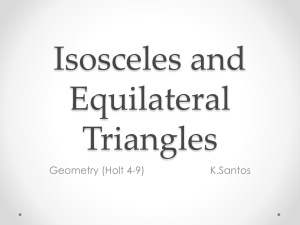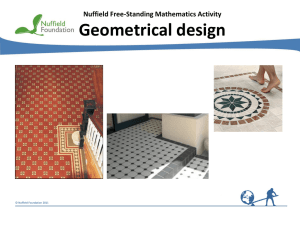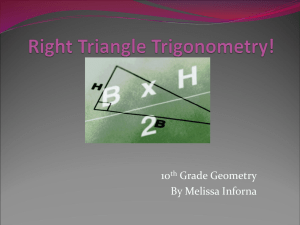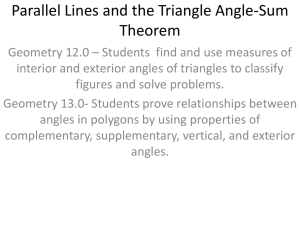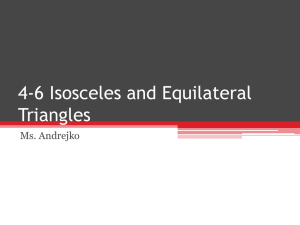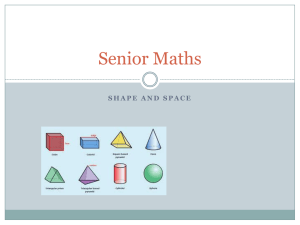104w03_chapter 2
advertisement
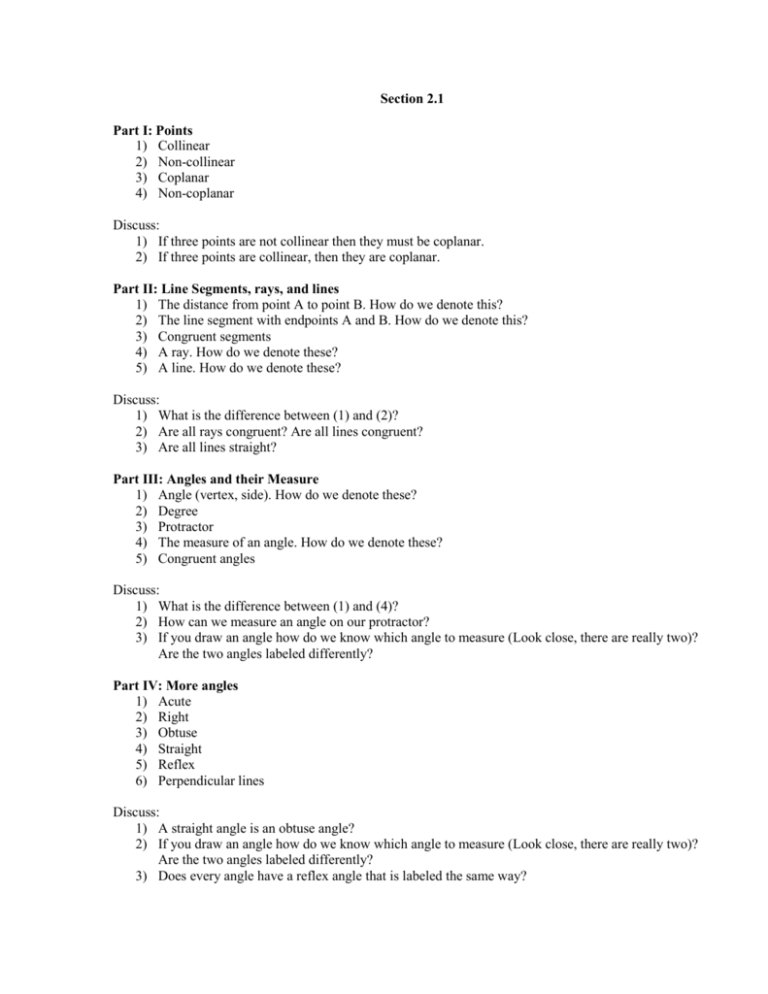
Section 2.1 Part I: Points 1) Collinear 2) Non-collinear 3) Coplanar 4) Non-coplanar Discuss: 1) If three points are not collinear then they must be coplanar. 2) If three points are collinear, then they are coplanar. Part II: Line Segments, rays, and lines 1) The distance from point A to point B. How do we denote this? 2) The line segment with endpoints A and B. How do we denote this? 3) Congruent segments 4) A ray. How do we denote these? 5) A line. How do we denote these? Discuss: 1) What is the difference between (1) and (2)? 2) Are all rays congruent? Are all lines congruent? 3) Are all lines straight? Part III: Angles and their Measure 1) Angle (vertex, side). How do we denote these? 2) Degree 3) Protractor 4) The measure of an angle. How do we denote these? 5) Congruent angles Discuss: 1) What is the difference between (1) and (4)? 2) How can we measure an angle on our protractor? 3) If you draw an angle how do we know which angle to measure (Look close, there are really two)? Are the two angles labeled differently? Part IV: More angles 1) Acute 2) Right 3) Obtuse 4) Straight 5) Reflex 6) Perpendicular lines Discuss: 1) A straight angle is an obtuse angle? 2) If you draw an angle how do we know which angle to measure (Look close, there are really two)? Are the two angles labeled differently? 3) Does every angle have a reflex angle that is labeled the same way? Part V: Still more angles 1) Complementary angles 2) Supplementary angles 3) Adjacent angles Discuss: 1) The three angles that make a triangle are supplementary? 2) Supplementary angles are adjacent angles? 3) Discuss the meaning of adjacent angles as on page 40 (second full paragraph) Further instructions: 1) Explain the terms in your part and discuss the discussion questions or comments. You should draw pictures, etc. There will not be time for me to repeat and clarify all of these terms, so please play the role of the teacher and be as clear as you can. 2) Find an even problem from the exercises in section 2.1 that is related to the terms from your part – show the class how to do it and discuss. 3) Write your own questions or comments for discussion (as I did) for your terms (two of these). 4) Write an exercise that tests the understanding of the terms in your part. This cannot be identical to the exercise that you worked in #1, but it can be a related problem. Section 2.2 Part I: Triangles 1) Triangle 2) Equilateral Triangle 3) Isosceles triangle (related terms: base, base angles, vertex) 4) Scalene triangle 5) Acute triangle 6) Right triangle (related terms: hypotenuse legs) 7) Obtuse triangle 8) Equiangular triangle Discuss: 1) An equilateral triangle is isosceles 2) An equilateral triangle is equiangular 3) A right triangle is isosceles 4) A right triangle is acute. Part II: Simple Closed curves 1) Simple closed curve 2) Circle (related terms: center, diameter, radius) 3) Polygon Discuss: 1) A variety of pictures (different than the books) of curves that are and are not simple closed curves. 2) A circle is a polygon 3) How are the radius and diameter related? 4) What capital letters of the alphabet are simple closed curves? Part III: Types of polygons 1) Triangle 2) Quadrilateral 3) Pentagon 4) Hexagon 5) Octagon 6) Decagon 7) Dodecagon(12) 8) N – gon Discuss: 1) Hexagons are equilateral 2) Draw several examples of each of these. Draw an equilateral and equiangular pentagon (if possible). Draw an equilateral hexagon that is not equiangular (if possible). 3) Can you think of common uses of these shapes? (This is not a yes-or-no question) Part IV: Types of quadrilaterals 1) Parallel lines (notation) 2) Square 3) Rectangle 4) Rhombus 5) Parallelogram 6) Trapezoid 7) Isosceles Trapezoid 8) Kite Discuss: 1) Explore relationships or overlap in the definitions of these quadrilaterals (as in the paragraph just above SYMMETRY on page 50). 2) Can all four sides of a Kite be congruent? 3) Write 10 Always, Sometimes, Never statements relating pairs of these quadrilaterals. These will be of the form “A ________ is a ____________”, where the blank are filled with names of two different quadrilaterals. You must have all 8 quadrilaterals somewhere in your 10 statements. Discuss your answers to these. Examples: (you can’t use these) a. “A square is a rectangle”. This is always true. b. A rectangle is a square”. This is sometimes true (when the four sides of the rectangle are congruent) Part V: Symmetry 1) Reflection symmetry (line of symmetry, axis of symmetry) 2) Rotation symmetry (center and angle of rotation symmetry) Discuss: 1) Explain the reflection and rotation symmetry of the equilateral triangle (how do they get 120 and 240 degrees of rotation?) 2) Discuss the reflection and rotation symmetry of an equilateral and equiangular pentagon. What would the angles of rotation be? Draw the reflection lines. 3) Discuss the reflection and rotation symmetry of a parallelogram. What would the angles of rotation be? Draw the reflection lines. Further instructions: 1) Explain the terms in your part and discuss the discussion questions or comments. You should draw pictures, etc. There will not be time for me to repeat and clarify all of these terms, so please play the role of the teacher and be as clear as you can. 2) Find an even problem from the exercises in section 2.1 that is related to the terms from your part – show the class how to do it and discuss. 3) Write your own questions or comments for discussion (as I did) for your terms (two of these). 4) Write an exercise that tests the understanding of the terms in your part. This cannot be identical to the exercise that you worked in #1, but it can be a related problem.

